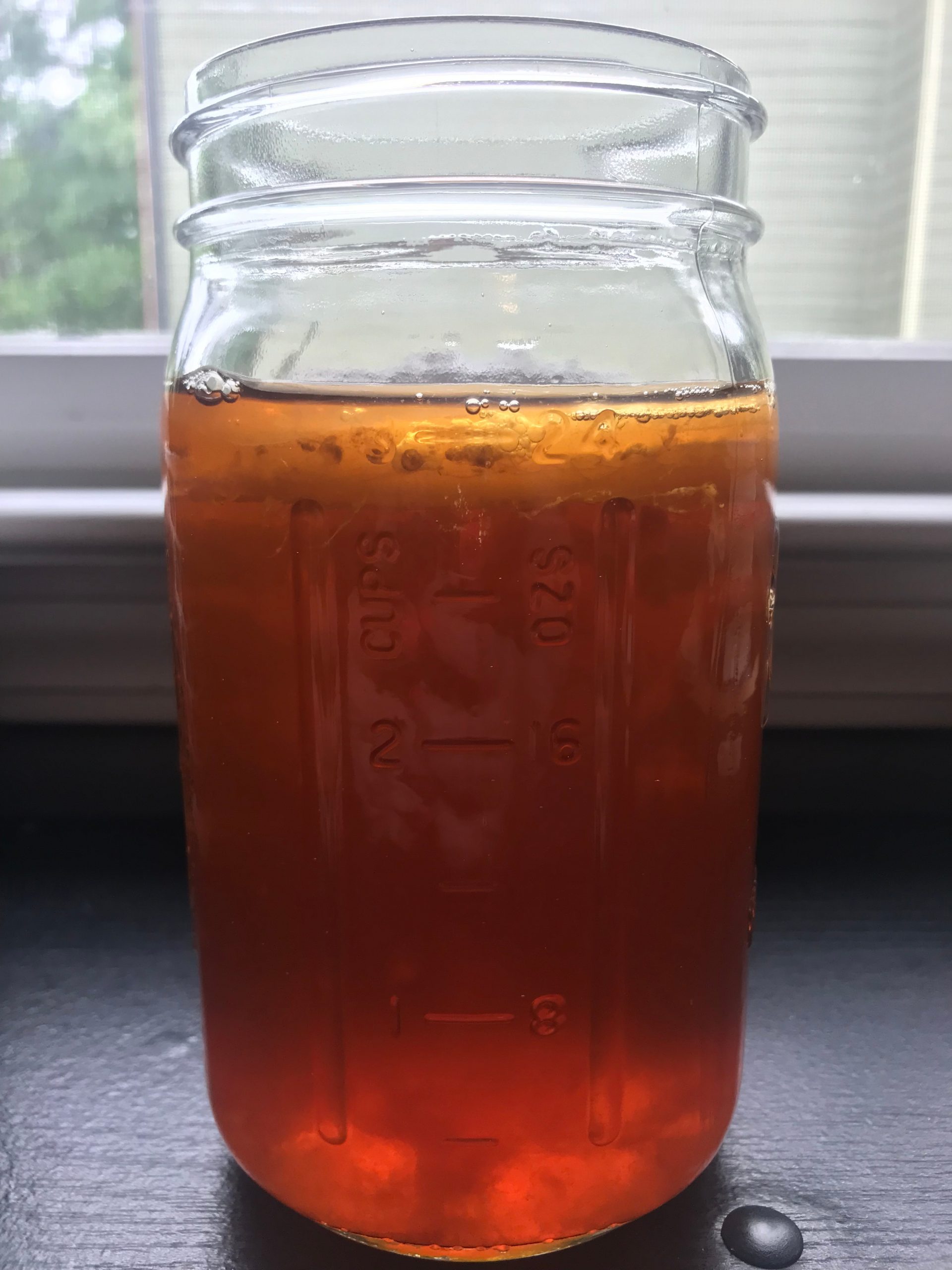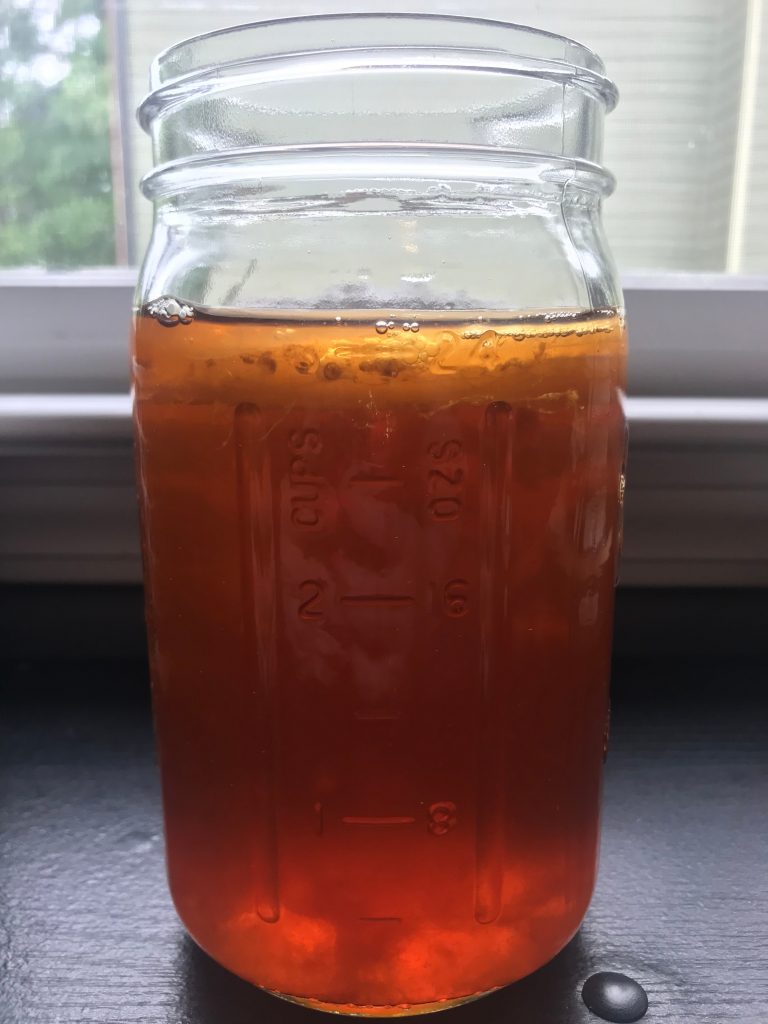Kombucha 101

Kombucha is a fermented tea drink that’s full of probiotics and postbiotics. Kombucha is pretty easy to make at home and can save money too!

WHAT IS KOMBUCHA?
Kombucha is a fermented tea drink usually made with black tea. The fermentation process turns the tea acidic as the bacteria in the mixture make vinegar as a byproduct. The tea is full of probiotics and postbiotics which may have some health benefits… but mostly it’s a tasty drink not a cure all!
HOW DOES IT WORK?
Kombucha is made by fermenting sweetened back tea or other teas like green tea or oolong tea. The fermenting process converts the sugar in the tea first into alcohol which is then converted into acetic acid or vinegar. The process leaves very little sugar and very little alcohol in the process. The resulting kombucha is acidic which provides flavor and prevents harmful bacteria from growing. If you want to read more about the science check out the article here!
Note: Commercially sold kombucha must be below 0.5% alcohol to be sold as non-alcoholic however, kombucha may not be suitable for people avoiding all alcohol even in minute amounts.
WHAT’S A SCOBY?
A SCOBY or symbiotic culture of bacteria and yeast is the colony of bacteria and yeast that live together and ferment the sweetened tea. A SCOBY looks like a flat pancake shape and is thick and slimy. The the bacteria and yeast also produce cellulose to build their biofilm ecosystem that they live in. With continued feeding of sugar and fresh tea to live in, the SCOBY will continue to grow and produce more kombucha. In every fermentation cycle, a new SCOBY will form at the top of the container. SCOBYs will also get thicker and more hardy the longer they are fed and used. After several ferments, a SCOBY should be retired.
HOW TO BEGIN FERMENTING
To begin fermenting, you will need a SCOBY. You can get one from a friend since they double every time you make a batch. You can also buy them from places that sell starter cultures. I got mine from NW Ferments which was local at the time (in Oregon), but they ship across the country too!
You can also make your own by starting with a bottle of store bought kombucha. The catch is that you want it to be plain because the flavoring can affect how the SCOBY grows. I’d recommend using GT’s Kombucha as a starter because they don’t filter out any of the bits of SCOBY that will grow in the bottle so it’s pretty active already. By mixing sweet brewed tea and the kombucha and letting it sit at room temperature for a few weeks you will hopefully get a thin SCOBY growing at the top of your container! Check out this article from The Kitchn for more details.
MAKING KOMBUCHA
Once you’ve got a SCOBY and some reserved kombucha for your starter your ready to ferment! For 1 quart of kombucha you’ll need:
- 3 cups water
- 2 back tea bags
- 1/4 cup evaporated cane sugar
- 1/4 reserved plain kombucha
- 1 SCOBY
To begin, brew the tea in the water warmed. Let the tea bags steep for about 5-6 minutes or until a dark back tea is brewed. Stir in the sugar with a non-metal spoon until dissolved. Let the tea mixture cool to room temperature because hot temperatures will kill the SCOBY. Once cooled, add the SCOBY and reserved starter kombucha and cover with a coffee filter or other breathable material. You want to keep bugs or dust out but let the mixture be exposed to the air. Let sit for about 1 week out of direct sunlight.
WHEN IS THE KOMBUCHA READY TO DRINK?
Short answer here is whenever you want! The longer answer is that there is no point in time where your brew is now kombucha. You can make your drink to your taste. If you are new to drinking kombucha or don’t love it yet, then if you stop the process sooner, then there will be more sugar left and less vinegar produced. A shorter fermenting time will make a less acidic, more sweet drink. If you want it to be more vinegary, then going longer will mean all the sugar you added got converted and it will be less sweet.
The best bet is to taste your mixture every couple of days to see where it’s at. You’ll learn what tastes best to you! Don’t worry if you forget about your ferment and it tastes like straight vinegar. Save 1/4 cup of liquid for each SCOBY you’ve got and dump the rest. You can start again with your fermenting friends.
When it tastes good, remove the SCOBYs (since a new one will grow) and save 1/4 cup of liquid per SCOBY (or per 1 quart for next batch) and put the rest in the fridge with a sealed lid to drink!
SECONDARY FERMENTING AND FLAVORING
Vinegary tea not really up your alley? Then you need the next step of the process called secondary fermentation! Once you’ve removed the SCOBY and liquid for the next round you can add flavor to your drink with fruit, juice, herbs, and spices. Add whatever flavor you’d like. In my pictures I added about 1/2 cup of blueberries for the quart container. This time cover the jar with a lid which will make some carbonation. Even though the SCOBY is gone, there are sill bacteria and yeast living in the tea (which makes it probiotic) and adding the fruit adds sugar to the mix too. So, the fermentation process will happen again except this time the lid is on so the carbon dioxide produced will be trapped in the jar creating a light fizz to your drink
BE CAREFUL! Watch your jars so too much pressure doesn’t build up. You need to burp your jars periodically. Burp is probably the best term ever, it just means to open the lid and let the air out. Also don’t ferment it cheap glass bottles that can’t withstand the pressure and can explode!
DOS AND DON’TS OF MAKING KOMBUCHA
DO wash your hands and materials before fermenting. Things don’t need to be sterile, but they need to be clean and sanitary.
DO check on your ferments periodically throughout the process. If you keep your eyes on them, then you’ll find the perfect fermenting time for your tastes and your environment.
DO play around with different flavors for your kombucha. And tell me what you come up with!
DON’T use a SCOBY that is green, pink, or fuzzy. They should only be tan brown color with maybe some brown strings hanging off.
DON’T drink anything with a bad or off-putting smell. When in doubt, throw it out!
DON’T make yourself sick by drinking something bad. If something seems off of gross, then dump your whole project and start over. Home-brewing is supposed to be fun, and it’s not worth getting sick over!
And now know the basics brewing your own kombucha at home! I have found kombucha to be the most forgiving ferment I’ve tried. So, if you’re looking for a quarantine project and sourdough isn’t your thing, maybe you can play around with kombucha. It’s a great science experiment to get kids involved with too!
